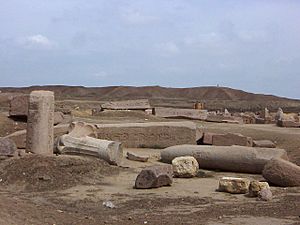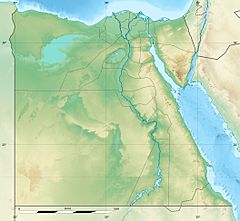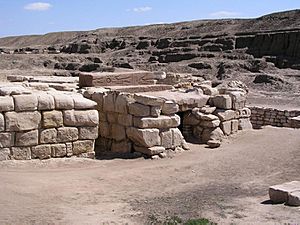Tanis facts for kids
Quick facts for kids
Tanis
صان الحجر
|
|
|---|---|

The ruins of Tanis today
|
|
| Country | |
| Governorate | Sharqia |
Tanis is the Greek name for an ancient Egyptian city called ḏꜥn.t. It is a very important archaeological site in the north-eastern Nile Delta in Egypt. The city was built on a branch of the Nile River, which has since dried up.
The first time Tanis was studied was in 1798 during Napoleon Bonaparte's trip to Egypt. An engineer named Pierre Jacotin made a map of the area. The first excavations (digging to find old things) happened in 1825 by Jean-Jacques Rifaud. He found two pink granite sphinxes, which are now in the Musée du Louvre museum. Later, François Auguste Ferdinand Mariette worked there from 1860 to 1864, and William Matthew Flinders Petrie from 1883 to 1886.
From 1929 to 1956, Pierre Montet took over the work. In 1939, he made an amazing discovery: a royal burial ground (necropolis) from the Third Intermediate Period. Since 1965, the French Mission of Tanis Excavations (MFFT) has been studying the site.
Today, you can still see the main parts of the temple built for the god Amun-Re. There are many large obelisks that once stood tall, marking different parts of the temple. These obelisks are now lying on the ground, possibly knocked down by a strong earthquake long ago. They are a key feature of the Tanis site, with archaeologists finding more than twenty of them.
Early archaeologists thought Tanis was the biblical city of Zoan. They believed this was where the Hebrews were enslaved by the pharaohs. Pierre Montet started his big digs in the 1930s hoping to prove this biblical connection. However, his discoveries slowly showed that this idea was not correct. The true location of Tanis in history was finally understood after the discovery of Qantir/Pi-Ramesses and new excavations led by Jean Yoyotte.
Contents
History of Tanis
When Was Tanis Built?
Tanis is not mentioned in records before the 19th Dynasty (around 1292–1189 BC). It became the capital of the 14th nome (a region) of Lower Egypt. An old temple writing from the time of Ramesses II mentions a "Field of Tanis." The city itself is clearly mentioned in two documents from the 20th Dynasty: the Onomasticon of Amenope and the Story of Wenamun. These texts say that the future pharaoh Smendes came from Tanis.
Why Did Tanis Become Important?
The oldest buildings found at Tanis are from the 21st Dynasty (around 1070–945 BC). Many older monuments found at Tanis were actually moved there from other nearby cities, especially from the previous capital, Pi-Ramesses.
At the end of the New Kingdom, the royal city of Pi-Ramesses was left empty. This happened because the Pelusiac branch of the Nile River became filled with mud, making its harbor unusable.
After Pi-Ramesses was abandoned, Tanis became the new center of power for the pharaohs of the 21st Dynasty. Later, it was also a capital for the 22nd Dynasty (along with Bubastis). These rulers used traditional titles and built many structures to show they were the rightful leaders of Egypt.
Temples and Burials
A great achievement of these kings was building and expanding the huge temple of Amun-Ra at Tanis. At this time, Amun-Ra became the main god in the eastern Delta, replacing Seth. Smaller temples were also built for the gods Mut and Khonsu. These three gods, Amun-Ra, Mut, and Khonsu, formed the Theban Triad in the city of Thebes. This shows that Tanis tried to be like Thebes, which was a very important religious center.
The new royal burial ground at Tanis also took the place of the one in the Theban Valley of the Kings. This was a very important change.
Later Years of Tanis
After the 22nd Dynasty, Tanis was no longer a royal capital. However, it still remained the capital of the 19th nome of Lower Egypt. Starting from the 30th Dynasty, Tanis began to grow again with new buildings. This continued during the Ptolemaic Period. People lived in Tanis until it was abandoned during Roman times.
In later centuries, Tanis was the home of the bishops of Tanis, who were part of the Coptic Orthodox Church. By the 7th century, Tanis had already become much smaller. In 1885, a census recorded that the city had a population of 1,569 people.
Discoveries at Tanis
Early Excavations
Even though Tanis was briefly explored in the early 1800s, the first big archaeological digs were done by Auguste Mariette in the 1860s. In 1866, Karl Richard Lepsius found a copy of the Canopus Decree at Tanis. This was a special stone inscription written in both Greek and Egyptian. Unlike the Rosetta Stone, which was found earlier, this one had a complete hieroglyphic text. This allowed experts to compare the Greek text directly to the hieroglyphs. This helped confirm that Jean-François Champollion's way of understanding hieroglyphs was correct.
For many years, archaeologists found so many monuments with the names of Ramesses II or Merenptah at Tanis. This made them think that Tanis and Pi-Ramesses were the same city. Also, finding the Year 400 Stela at Tanis led to ideas that Tanis might also be the older capital of the Hyksos people, called Avaris.
However, later discoveries of the actual sites of Pi-Ramesses (Qantir) and Avaris (Tell el-Dab'a) showed that these ideas were wrong. All the monuments from Ramesses' time and earlier found at Tanis were actually brought there from Pi-Ramesses or other cities.
Royal Tombs and Treasures
At Tanis, you can see the ruins of several temples, including the main temple dedicated to the god Amun. There is also a very important royal necropolis (burial ground) from the Third Intermediate Period. This necropolis holds the only known royal pharaonic burials that were found mostly untouched by tomb robbers. The famous tomb of Tutankhamun had been entered in ancient times, but these tombs at Tanis were still intact.
The tombs of three pharaohs from the 21st and 22nd Dynasties – Psusennes I, Amenemope, and Shoshenq II – were found untouched. Pierre Montet discovered them in 1939 and 1940. These tombs contained a huge collection of gold, jewelry, lapis lazuli, and other precious stones. They also had the beautiful funerary masks of these kings.
The main gods worshipped in Tanis were Amun, his wife Mut, and their child Khonsu. These three gods formed what is known as the Tanite triad. This group of gods was exactly the same as the one worshipped in Thebes. Because of this, many experts called Tanis the "northern Thebes."
Recent Discoveries
In 2009, the Egyptian Culture Ministry announced that archaeologists had found a sacred lake in the temple of Mut at Tanis. This lake was made of limestone blocks and was 15 meters long and 5 meters deep. It was found 12 meters underground and was in good condition. Experts believe the lake might have been built during the late 25th Dynasty or early 26th Dynasty.
In 2011, an archaeologist named Sarah Parcak used high-resolution satellite images to study Tanis. She found many mud-brick walls, streets, and large homes, showing a complete city plan in an area that looked empty in normal images. A French archaeology team chose a spot from these images and confirmed that there were mud-brick structures about 30 centimeters below the surface.
Gallery
-
Pharaoh Osorkon II's tomb at Tanis
-
The gold funerary mask of Psusennes I
See also
 In Spanish: Tanis (Egipto) para niños
In Spanish: Tanis (Egipto) para niños







